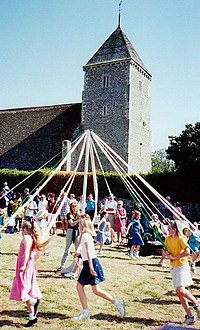May Day parade
| May Day | |
|---|---|

|
|
| Date | 1 May |
| Next time | 1 May 2018 |
May Day is a public holiday usually celebrated on May 1. It is an ancient northern hemisphere spring festival. It is also a traditional spring holiday in many cultures. Dances, singing, and cake are usually part of the celebrations that the day includes.
In the late 19th century, May Day was chosen as the date for International Workers' Day by the Socialists and Communists of the Second International to commemorate the Haymarket affair in Chicago.International Workers' Day may also be referred to as "May Day", but it is a different celebration from the traditional May Day.
The earliest May Day celebrations appeared with the Floralia, festival of Flora, the Roman goddess of flowers, held on April 27 during the Roman Republic era, and with the Walpurgis Night celebrations of the Germanic countries. It is also associated with the Gaelic Beltane, most commonly held on April 30. The day was a traditional summer holiday in many European pagan cultures. While February 1 was the first day of spring, May 1 was the first day of summer; hence, the summer solstice on June 25 (now June 21) was Midsummer.
As Europe became Christianised, the pagan holidays lost their religious character and May Day changed into a popular secular celebration. A significant celebration of May Day occurs in Germany where it is one of several days on which St. Walburga, credited with bringing Christianity to Germany, is celebrated. The secular versions of May Day, observed in Europe and North America, may be best known for their traditions of dancing around the maypole and crowning the Queen of May. Fading in popularity since the late 20th century is the giving of "May baskets," small baskets of sweets or flowers, usually left anonymously on neighbours' doorsteps.
...
Wikipedia
